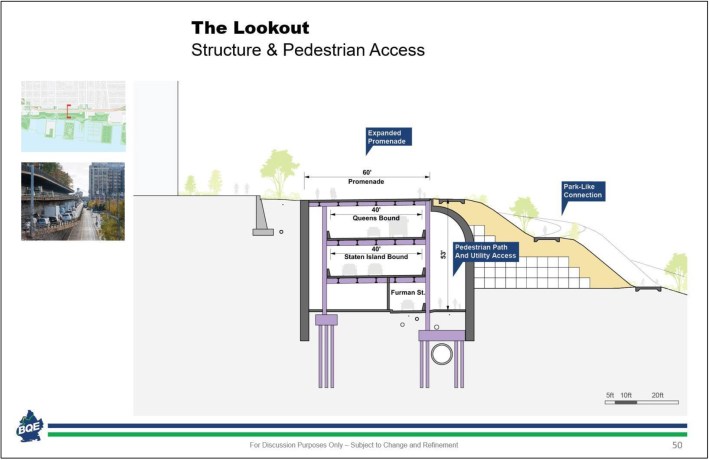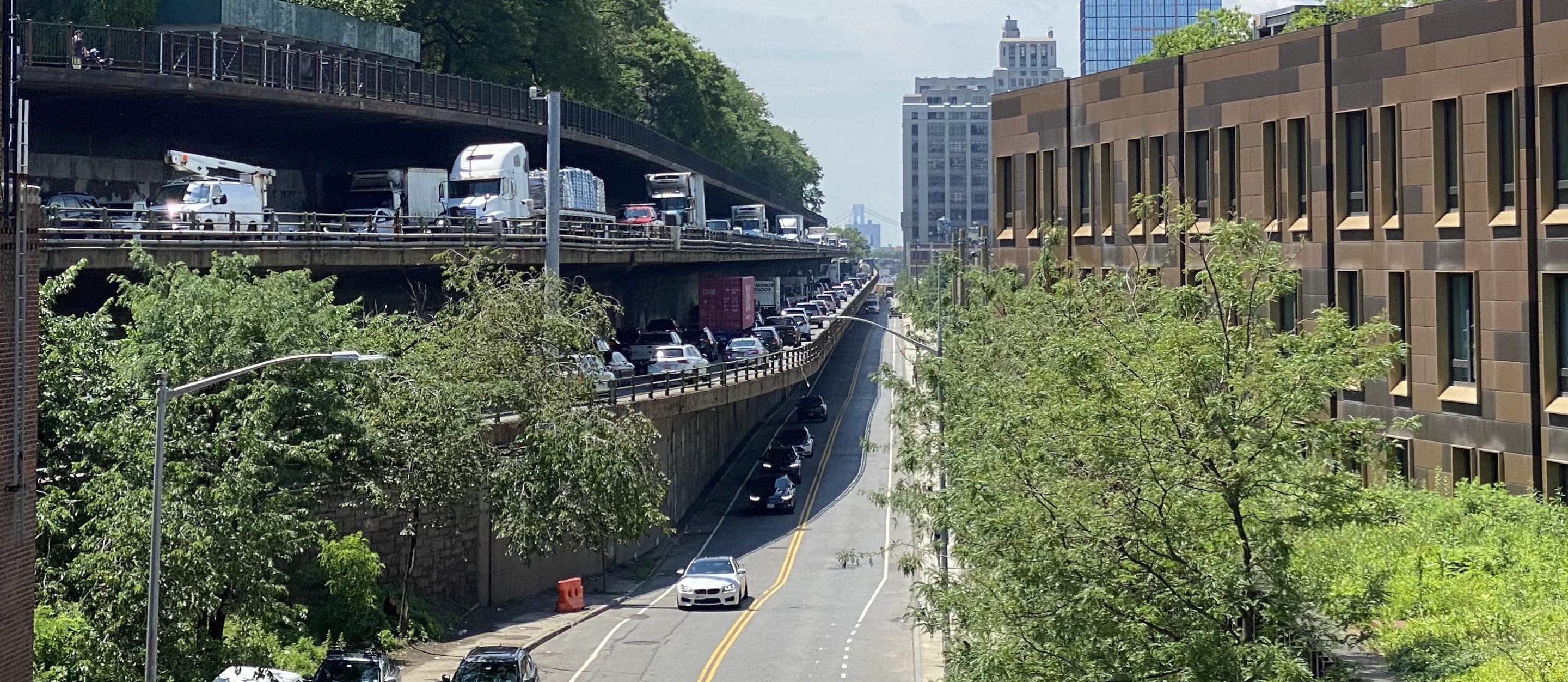Not so fast.
Two former city transportation leaders warned that rebuilding a section of the Brooklyn-Queens Expressway to three lanes of federally mandated width could intrude on Brooklyn Bridge Park — one of the most expensive urban parks ever built.
The city plans to reconstruct the crumbling triple-cantilever section of the BQE between Atlantic Avenue and Sands Street with two or three 12-foot lanes in each direction — configurations that would require the 33.5-foot-wide highway to expand to between around 38 to 56 feet when the federally required shoulders are added in.
"Making it three [wider] lanes in each direction means a tougher problem to solve and probably intrusion into Brooklyn Bridge Park," "Gridlock" Sam Schwartz, who served as the city's Traffic Commissioner in the 1980s, said on WNYC's Brian Lehrer Show.
Schwartz's comments immediately caused a stir in the city's close-knit transportation world, with previous Department of Transportation Commissioner and longtime booster of Brooklyn Bridge Park, Hank Gutman, reiterating his support for protecting the waterfront green space.
"Sam is absolutely right that expanding the footprint of the highway would seriously damage Brooklyn Bridge Park. So would a temporary highway and many of the other things that the DOT is apparently considering," Gutman told Streetsblog after Schwartz's radio appearance.
Gutman helped create the 85-acre green space atop former dilapidated piers as a member of the Brooklyn Bridge Park Conservancy, and he still sits on the park's board of directors. The park cost a whopping $400 million to build — one of the most expensive such projects in history — and now draws about five million visitors a year.
For its part, a DOT spokesman reiterated that the Adams administration is only studying whether to rebuild the crumbling highway into two or three lanes in each direction. The roadway, roughly 34 feet wide in each direction, is currently configured as two lanes of travel, plus a shoulder, to reduce wear and tear.
The spokesman pushed back on Schwartz and Gutman's fears that the renovated highway — whether two or three lanes — would intrude on any green space.
"This administration’s vision ... will create more green space and, for the first time, connect Brooklyn Bridge Park to the Brooklyn Heights promenade," said Vin Barone in a statement. "Any suggestion that our plan would take away green space is patently false, as proven by the design concepts we’ve discussed with hundreds of community members across several public events."
DOT's conceptual renderings of a future highway do indeed show substantial new open spaces covering the roadways and sloping down to Brooklyn Bridge Park. But the renderings are based on a 40-foot-wide stacked highway in each direction:
Forty feet represents a rebuilt two-lane highway, according to modern federal standards that call for 12-foot-wide lanes, plus a 10-foot shoulder on the right and a four-foot shoulder on the left.
Three lanes and their shoulders would require a total width of between 50-56 feet under federal regulations, but city Transportation officials said they can carve out 60 feet in the current footprint by building into the space of the tiered structure.

Many local officials want the roadway to remain at two lanes to reduce the impact of the car on local communities and air. But the DOT said back in December [see page 22], "We expect that the analysis ... will result in three lanes of traffic.”
Schwartz later told Streetsblog that a stacked highway could fit into an area outside the park, but the traffic veteran added there would also have to be room to stage massive equipment during construction, which is slated to begin in 2027 and take a long time to complete.
"The narrower you make it, the easier it is to construct," Schwartz said. "I don’t know what construction techniques they plan on using, but no matter what, it’s going to involve big machinery."
A Brooklyn Bridge Park spokeswoman said park officials had been assured the repairs would not reduce green space.
"The adjacent BQE repair project is a critical infrastructure project, and we are working closely with DOT and the rest of the Adams Administration. The Park has been assured that, with any proposal, there will be no loss of green space," said Sarah Krauss.
DOT officials have said that one justification for a wider roadway stems from increases in congestion and truck traffic on adjacent neighborhood streets following the conversion to two lanes two years ago. But officials also failed to follow recommendations by an expert panel to curb congestion on and near the BQE, which many motorists use to dodge tolls going into Manhattan.
Schwartz's former firm came up with many of the recommendations for the panel released three years ago. The engineers found the roadway could work with just two lanes if officials tried to discourage driving by closing some ramps or limiting them to high-occupancy vehicles, or by charging to cross the East River bridges at the same rates as the tolled Hugh Carey Tunnel.
Conflicts between the highway's much-needed renovation and the park date back to before the green space was even built.
Back in 2007, Federal Highway Administration experts found that plans to renovate the highway by the state — which was originally in charge of the project until former Gov. Andrew Cuomo dumped it on the city in 2011 — would negatively affect the park, but Albany officials told locals that both projects could "complement each other" without going into details, the Brooklyn Paper reported in 2008.






